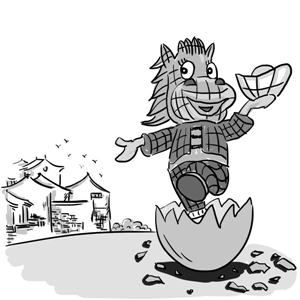
Illustration: Chen Xia/GT
Over the past week journalists and commentators in Shanghai have had no trouble finding news stories to write about.
The unfinished Shanghai Tower received unprecedented media exposure after two skywalkers, under the pseudonyms Vadim Makhorov and Vitaliy Raskalov, blew up the Internet by posting their skyscraper-scaling video online. Their daredevil stunt raised an alarm bell for the security of construction sites in the city and indeed across the whole country. What if the two climbers were not satisfied with just conquering the tower and taking pictures on the top? We have no idea whether anybody in charge of security at the Shanghai Tower construction site was punished. But city authorities did announce that measures will be taken to prevent any similar acts from being undertaken in future.
On Tuesday, the death sentence of Fudan University postgraduate medical student Lin Senhao once again stirred heated debate over the death penalty. Lin poisoned his roommate Huang Yang on April 1 last year by injecting a fatal chemical into the water dispenser in the dorm room they shared. Huang died of multiple organ failure on April 16. I believe that Lin deserved the death sentence because only harsh punishment can demonstrate respect for life. A more lenient sentence would potentially encourage other sociopaths to copy homicide cases.
Besides the big news, another seemingly insignificant news story came to my attention.
The Oriental Morning Post reported Wednesday that the ornamental festival lanterns in Yuyuan Garden, near the City God Temple, wouldn't be discarded this year. They are being moved to a new home.
The Yuyuan Garden lantern show is always a highlight in Shanghai during Spring Festival. The annual lantern fair in the tourist site usually starts on Chinese New Year's Eve and runs until the Lantern Festival. The two-week fair draws local residents and tourists from around the world as well. There is a different theme every year, generally one which reflects the zodiac year of the Chinese lunar calendar.
Every year millions of yuan is spent on designing and manufacturing the lanterns. Because of the limited space, all the lanterns are customized based on the size and layout of Yuyuan Garden. But after the Lantern Festival, the lanterns are taken down, with a very small portion of the parts, such as bulbs and engines, getting collected for recycling. The site administrators admit this is a huge waste every year, according to the news report.
However, this year marked a change. Starting from February 17, the lanterns have been taken down in Yuyuan and sent to rural districts in Jiading and Jinshan.
The lanterns will be given a new lease of life in the gardens there as part of a local tourism project from March 1 to April 1. In Jinshan, there is a traditional lantern and riddle fair every year. Local residents and visitors take part in the traditional practice of solving riddles while appreciating the lanterns. Generally there are prizes for those who solve the riddles. Even in some communities in downtown Shanghai, the tradition has been kept and enjoyed by local residents.
It's no doubt a win-win experiment for Yuyuan Garden and Jinshan district. The life span of the lanterns get prolonged and many more people can enjoy the beautifully made decorations. According to an official from Jinshan, the district will only spend a modest amount of money to transport and re-install the lanterns, which they say is worthwhile considering the value the re-purposed lanterns will bring to the local tourism industry.
Later is better than never. The public is definitely happy to see this new practice implemented. Hopefully it represents a new start and not a one-off campaign.
The project reminds me of the World Expo 2010 in Shanghai. Prior to the Expo, the designated area turned into a grand construction site. Over time, spectacular architecture mushroomed in the area. Then from May 1 to October 31, people across the world experienced a crowded and dazzling Expo in China.
And what happened next? The majority of the buildings were dismantled with only a small number remaining that are now used as exhibition venues or for other commercial purposes. Critics called it "an expo of construction and destruction." Although large-scale events tend to be wasteful, there is still space to achieve better outcomes. We can't justify excess by claiming that it's always been this way or it's widely accepted.
This is not the first year that Yuyuan has held the lantern fair, but this year it made a breakthrough in curbing waste. This practice can and should be copied and promoted in many other fields.
There are many grand annual events in the city organized by both government departments and private companies. Large sums of money get approved in the planning stage and most organizers have no incentive to be prudent so long as they keep costs under budget.
I have reason to assume that with the central government's anti-extravagance campaign still in high gear, control of waste will be tougher than ever before. Using money and material resources wisely will be the top consideration for event organizers. The recent Yuyuan Garden practice can be a good model for both the city government and the business world.
The author is the managing editor of Global Times Metro Shanghai. fengyu@globaltimes.com.cn

